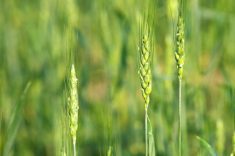A lack of soil moisture in Australia’s eastern grain belt could hit wheat production in the world’s second largest exporter as farmers start seeding the 2013-14 crop.
Concerns over Australia’s wheat output come as the U.S. crop faces winter storms after being planted in dry soil last year, piling pressure on global grain supplies and setting the stage for higher benchmark Chicago prices.
The market in Australia has already started building a weather premium into new-crop wheat prices as farmers plant grain in dry soil in New South Wales and Victoria, parts of which have seen little rainfall over the past months.
Read Also

Calling for bigger crops ahead of StatCan report
Statistics Canada will release its first survey-based production estimates for the 2025/26 crop year on Dec. 4, with general expectations for upward revisions to most major crops from the model-based estimates in September. However, as StatCan has shown a tendency to underestimate production in its December reports, many analysts expect actual production may be revised upward in subsequent reports.
“We have some real issues in Australia at the moment as quite a few producers are saying that they are not going to plant anything now as they don’t have subsoil moisture,” said Ole Houe, an analyst at Sydney-based brokerage IKON Commodities.
“There are cracks on the ground.”
A smaller crop would hurt the country’s exports of the grain, which could decline to around 14-15 million tonnes in the year to September 2014, analysts said. It is expected to ship some 19 million tonnes this year, down from a record 23 million tonnes in 2011-12.
The Australian Bureau of Agriculture and Resource Economics and Sciences forecasts the country’s wheat production to rise 13 per cent to 24.9 million in 2013-14, but analysts and industry officials are skeptical.
“Planting in dry soil is OK if you get well timed rains, but if you don’t then it could a problem,” said a Melbourne-based analyst. “The worry is that we haven’t seen a break in the dryness trend.”
Chicago Board of Trade wheat futures on Tuesday were buoyed by the poor condition of the U.S. crop, which suffered from the worst drought in 50 years at the time of planting last year.
The condition of U.S. winter wheat matched an 11-year low in the latest week, with just 36 per cent of the crop rated good-to-excellent, down from 64 percent last year, the U.S. Department of Agriculture said Monday.
In Australia, the price of new-crop prime wheat for January shipment rose $10 a tonne to around $314, free on board, this week on the worries over dryness.
Hoping for rain
The soil moisture in southern parts of New South Wales was less than 30 per cent of historical averages in the week ending April 7, according to the Commonwealth Scientific and Industrial Research Organization. In parts of Victoria, the soil moisture was less than 20 per cent of average.
Typically farmers in New South Wales and Victoria produce Australian hard wheat and standard white wheat.
Widespread rains across Australia’s dry grain belt over the next month could reverse the situation but there is not much rainfall forecast, Australian Bureau of Meteorology charts show.
“Unfortunately, the outlook for the next week isn’t so good and our current outlook for parts of the southern wheat growing area is for average to below average rainfall over the next three months,” said Andrew Watkins, climate manager at the weather agency.
Western Australia, the country’s biggest wheat exporting region, also faces dry conditions, but these are not yet a concern.
“The wheat crop in western Australia relies on in-crop rainfall as opposed to the eastern crop,” said Houe. “And it is typically dry at this time of year.”
Australia’s wheat exports have been running at a breakneck pace this year, with analysts estimating supplies will dry up much before the marketing year ends in September.
Australia’s closing stocks of wheat may dwindle to around two million to three million tonnes, from eight million tonnes a year ago, analysts and industry officials have said.
— Naveen Thukral and Colin Packham write for Reuters from Singapore and Sydney respectively.














